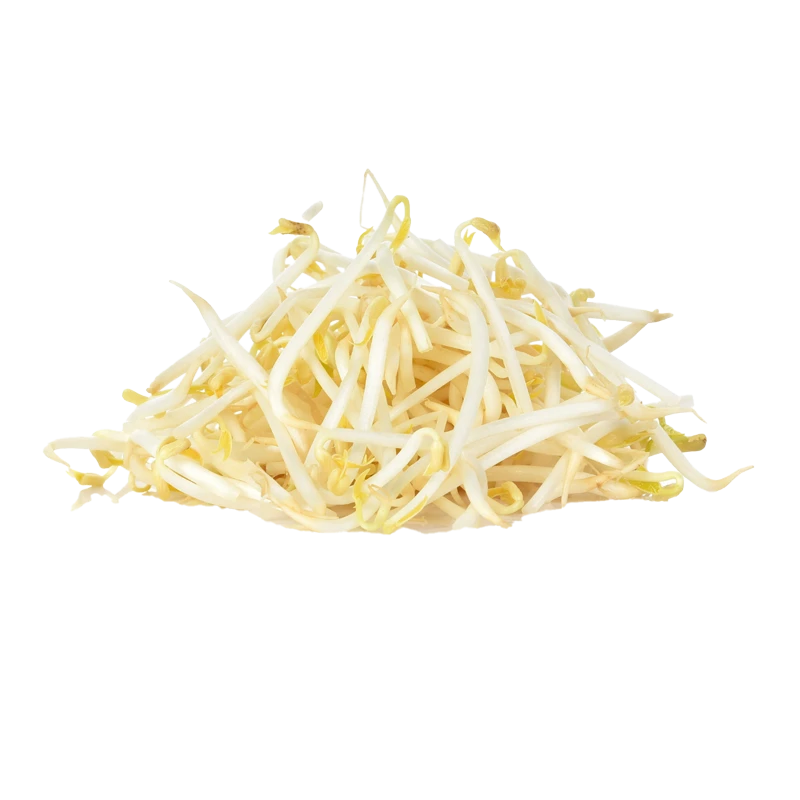Bean Sprouts — Nutrients, Health Benefits, And Shopping Tips

Written by Listonic Team
Last update on September 4, 2024
Bean sprouts nutrients
Nutrition facts
Amount per 100 g
Calories
🔥 30 kcal
| Nutrition per: 100 g | Value | % Daily Value* |
|---|---|---|
| Carbs | 6 g | 2.18% |
| Fiber | 2 g | 7.14% |
| Sugars | 4 g | 8% |
| Glycemic Index | 25 | - |
| Protein | 3 g | 6% |
| Sodium | 6 mg | 0.26% |
| Total Fat | 0 g | - |
*The % of Daily Value (DV) tells you how much a nutrient in a serving of food contributes to a daily diet. 2,000 calories a day is used for general nutrition advice.
30
🍏 Low-Calorie Foods
25
🟢 Low Glycemic Index
Bean sprouts facts & tips
Health benefits
- Rich in vitamins and minerals such as Vitamin C, Vitamin K, folate, and iron, which support overall health and well-being.
- High in fiber, promoting digestive health, regular bowel movements, and maintaining a healthy gut microbiome.
- Low in calories, making them a nutritious option for weight management.
- Contains antioxidants, which help protect the body from free radicals and reduce inflammation.
Health risks
- Risk of contamination with harmful bacteria such as E. coli, Salmonella, or Listeria, particularly in raw or undercooked sprouts, which can lead to foodborne illness.
- Potential for digestive discomfort such as bloating, gas, or stomach cramps when consumed in large quantities, particularly in individuals sensitive to high-fiber foods.
- Risk of allergic reactions in some individuals, particularly those allergic to specific types of sprouts (e.g., alfalfa, mung bean), causing symptoms like itching, swelling, or difficulty breathing.
- Potential for goitrogenic effects in certain sprouts like broccoli or radish, which may interfere with thyroid function in sensitive individuals, especially when consumed in large quantities.
How to choose bean sprouts
Bean sprouts should be crisp and moist, with a pale color and tender texture. The roots should be short and clean, and the sprouts should have a fresh, subtle flavor.
Avoid bean sprouts that are limp or discolored, as these are signs of aging. Sprouts with a slimy texture or an off smell should also be avoided, as they are likely spoiled and potentially harmful to consume.

How to store bean sprouts
Bean sprouts should be stored in the refrigerator, ideally in a perforated plastic bag. Refrigeration maintains their crispness and freshness for up to a week.
Excess moisture can cause bean sprouts to spoil quickly. Avoid washing before storage to prevent mold growth. Always check for signs of spoilage, such as sliminess, before use.
✅ Extra Tip
How long do they last?
Bean sprouts can last for 1-2 weeks in the refrigerator when stored in a plastic bag or container. For best results, keep them in the crisper drawer and away from excess moisture. Proper storage helps maintain their crispiness and freshness.
What to do with leftovers?
Leftover bean sprouts can be used in a variety of fresh and crunchy dishes. Add them to salads, stir-fries, or grain bowls for added texture and nutrition, or mix them into a spring roll with vegetables, shrimp, and peanut sauce. Bean sprouts are also great when used as a topping for soups, pho, or ramen.
Use bean sprouts in a stir-fry with vegetables and your choice of protein, or mix them into a pasta salad with fresh vegetables and a tangy dressing. If you have a lot of bean sprouts, consider making a batch of sprout slaw by mixing them with shredded cabbage, carrots, and a vinegar-based dressing. Bean sprouts can also be used as a filling for tacos, wraps, or sandwiches, adding a fresh crunch to every bite. For a quick snack, enjoy bean sprouts with a drizzle of soy sauce and sesame seeds, or mix them into a salad with greens and a ginger dressing.
👨⚕️️ Medical disclaimer
Discover products from other categories
Listonic Team
Fact-checked
Our editorial team checked this article to make sure it was accurate at the time of publishing it.
Get the top-rated shopping list app on your phone!







